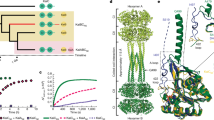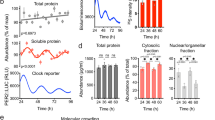Abstract
The circadian clock is considered to be a universal feature of eucaryotic organisms, controlling the occurrence and rates of many different aspects of life, ranging from single enzymatic reactions and metabolism to complex behaviours such as activity and rest1. Although the nature of the underlying cellular/biochemical oscillator is still unknown2, many substances are known to influence either phase or period of circadian rhythms in different organisms. These include D2O3,4, electrolytes5 and ion channel inhibitors5,6, small organic molecules such as alcohols7,8 and aldehydes9, inhibitors of protein synthesis10–12 and ammo-acid analogues13,14. Certain transmitter15 and neurochemical drugs16,17 also influence the circadian clock in higher animals. We report here that the period of free-running circadian rhythms in the unicellular marine alga Gonyaulax polyedra is shortened by extracts from mammalian cells. The effect is dose-dependent, accelerating the circadian clock by as much as 4 hours per day. The substance responsible for this effect has been isolated from bovine muscle and identified as creatine. Authentic creatine has identical biological effects at micromolar concentrations and is known in animal systems for its involvement in cellular energy metabolism. A period shortening substance with similar chemical properties is also present in extracts of Gonyaulax itself.
This is a preview of subscription content, access via your institution
Access options
Subscribe to this journal
Receive 51 print issues and online access
$199.00 per year
only $3.90 per issue
Buy this article
- Purchase on Springer Link
- Instant access to full article PDF
Prices may be subject to local taxes which are calculated during checkout
Similar content being viewed by others
References
Johnson, C. H. & Hastings, J. W. Am. Scient. 74, 29–36 (1986).
The Molecular Basis of Circadian Rhythms (eds Hastings, J. W. & Schweiger, H.-G.) (Dahlem Conferences, Berlin, 1976).
Bruce, V. G. & Pittendrigh, C. S. J. Cell. comp. Physiol. 56, 25–31 (1960).
McDaniel, M., Sulzman, F. M. & Hastings, J. W. Proc. natn. Acad. Sci. U.S.A. 71, 4389–4391 (1974).
Schmid, H. P. & Engelmann, W. J. interdiscipl. Cycle Res. 16, 324 (1986).
Kondo, T. J. biol. Rhyth. (submitted).
Enright, J. T. J. comp. Physiol. 75, 332–346 (1971).
Taylor, W., Gooch, V. D. & Hastings, J. W. J. comp. Physiol. B 130, 355–358 (1979).
Taylor, W. & Hastings, J. W. J. comp. Physiol. B 130, 359–362 (1979).
Karakashian, M. W. & Hastings, J. W. J. gen. Physiol. 47, 1–12 (1963).
Feldman, J. F. Proc. natn. Acad. Sci. U.S.A. 57, 1080–1087 (1967).
Rothman, B. & Strumwasser, F. J. J. gen. Physiol. 68, 359–384 (1976).
Hastings, J. W., Broda, H. & Johnson, C. H. in Temporal Order (eds Rensing, L. & Jäger, N. I.) 213–221 (Springer, Berlin, 1985).
Kondo, T. Pl. Physiol. (submitted).
Corrent, G., & Eskin, A. Am. J. Physiol. 11, R333–338 (1982).
Turek, F. W. & Losee-Oolsen, S. Nature 321, 167–168 (1986).
Ralph, M. R. & Menaker, M. Brain Res. 325, 362–365 (1985).
Njus, D., Gooch, V. & Hastings, J. W. Cell Biophys. 3, 223–231 (1981).
McMurry, L. & Hastings, J. W. Science 175, 1137–1139 (1972).
Taylor, W., Wilson, S., Presswood, R. P. & Hastings, J. W. J. interdiscipl. Cycle Res. 13, 71–79 (1982).
Tombes, R. M. & Shapiro, B. M. Cell 41, 325–334 (1985).
Bessman, S. P. Analyt. Biochem. 161, 519–523 (1987).
Bessman, S. P. & Fonyo, A. Biochem. biophys. Res. Commun. 22, 597–602 (1966).
Jacobus, W. E. & Lehninger, A. L. J. biol. Chem. 248, 4803 (1973).
Wagner, E., Tetzner, J., Haertle, U. & Deitzer, G. F. Ber. Deutsch. Bot. Ges. 87, 291–302 (1974).
Delmer, D. P. & Brody, S. J. Bact. 121, 548–553 (1975).
Atkinson, D. E. Adv. Enzyme Regal. 9, 207–219 (1971).
Wagner, E. in The Molecular Basis of Circadian Rhythms (eds Hastings, J. W. & Schweiger, H.-G.) 215–238 (Dahlem Conferences, Berlin, 1976).
Loike, J. D., Somes, M. & Silverstein, S. C. Am. J. Physiol. 251, C 128–135 (1986).
Loike, J. D., Zalutsky, D. L., Kanack, E., Miranda, A. F. & Silverstein, S. C. Proc. natn. Acad. Sci. U.S.A. (in the press).
Author information
Authors and Affiliations
Rights and permissions
About this article
Cite this article
Roenneberg, T., Nakamura, H. & Hastings, J. Creatine accelerates the circadian clock in a unicellular alga. Nature 334, 432–434 (1988). https://doi.org/10.1038/334432a0
Received:
Accepted:
Published:
Issue Date:
DOI: https://doi.org/10.1038/334432a0
This article is cited by
-
Zelluläre Mechanismen der inneren Uhr eines Einzellers
The Science of Nature (1994)
-
Effects of deuterium oxide and temperature on heart rate in Drosophila melanogaster
Journal of Comparative Physiology B (1992)
-
Gonyauline: A novel endogenous substance shortening the period of the circadian clock of a unicellular alga
Experientia (1991)
Comments
By submitting a comment you agree to abide by our Terms and Community Guidelines. If you find something abusive or that does not comply with our terms or guidelines please flag it as inappropriate.



